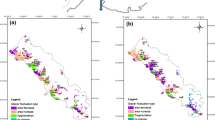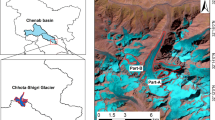Abstract
Recent changes occurred in terminus of the debris-covered Bilafond Glacier in the Karakoram Range in the Himalayas, Northern Pakistan was investigated in this research. Landsat MSS, TM and ETM+ images were used for this study. Digital elevation models derived from ASTER GDEM and SRTM were also utilized. Visible, infrared and thermal infrared channels were utilized in order to get accurate glacier change maps. Three methods were tried to map this debris-covered glacier in this research. The glacier has been mapped successfully and the changes in the glacier terminus from 1978 to 2011 have been calculated. Manual, semi-automatic and thermal methods were found to give similar results. It was found that the glacier has undergone serious ablation during this period despite of the fact that many of the larger glaciers in the Hindu Kush and Karakoram mountain regions in the Upper Indus Basin were reported to be expanding. The terminus has been moved back about 600 meters during this period and there was an abrupt change in the glacier terminus during 1990–2002. We propose that debris thickness is not the only factor that influences the glacier ablation but the altitude of the debris-covered glacier as well. Many glaciers in the Karakoram region reported to be expanding were having higher altitudes compared to the study area.
Similar content being viewed by others
References
Amstrong RL (2010) The Glaciers of the Himalayan-Hindu-Kush region. Technical Paper, Kathmandu, Nepal: The International Centre for Integrated Mountain Development (ICIMOD). p 20.
Bajracharya SR, Sreshtha B (2011) The status of glaciers in the Hindu Kush — Himalayan region. In: Technical Paper, the International Centre for Integrated Mountain Development (ICIMOD), Kathmandu, Nepal. p 140.
Basistha A, Arya DS, Goel NK (2009) Analysis of historical changes in rainfall in the Indian Himalayas. International Journal of Climatology 29: 555–572. DOI: 10.1002/joc.1706
BBC News (2012) Kashmir avalanche: Up to 135 feared dead on Siachen. Available online: http://www.bbc.co.uk/news/world-asia-17647029 (Accessed on 8 April 2012)
Bhambri R, Bolch T, Chaujar RK, et al. (2011) Glacier changes in the Garhwal Himalaya, India, from 1968 to 2006 based on remote sensing. Journal of Glaciology 57: 543–556. DOI: 10.3189/002214311796905604
Bolch T, Buchroithner MF, Kunert A, et al. (2007) Automated delineation of debris-covered glaciers based on ASTER data. In: Proceeding of the 27th EARSel Symposiumm Bozen, Italy, 4–7 June, 2007. pp 403–410.
Bolch T, Kulkarni A, Kaab A, et al. (2012) The state and fate of Himalayan glaciers. Science 336: 310–314. DOI: 10.1126/science.1215828
Fowler HJ, Archer DR (2006) Conflicting signals of climatic change in the Upper Indus Basin. Journal of Climate 19: 4276–4293. DOI: 10.1175/JCLI3860.1
Frey H, Paul F (2012) On the suitability of the SRTM DEM and ASTER GDEM for the compilation of topographic parameters in glacier inventories. International Journal of Earth Observation and Geoinformation 18: 480–490. DOI: 10.1016/j.jag.2011.09.020
Frey H, Paul F, Strozzi T (2012) Compilation of a glacier inventory for the western Himalayas from satellite data: methods, challenges and results. Remote Sensing of the Environment 124: 832–843. DOI: 10.1016/j.rse.2012.06.020
Grondona AEB, Veettil BK, Rolim SBA (2013) Urban Heat Island development during the last two decades in Porto Alegre, Brazil and its monitoring. In: Proceedings of the Joint Urban Remote Sensing Event (JURSE) 2013, Sao Paulo, Brazil, 21–23 April 2013. pp 1–4.
Gurung J, Bajracharya RM (2012) Climate change and glacial retreat in the Himalaya: Implications for soil and plant development. Kathmandu University Journal of Science, Engineering and Technology 8: 153–163.
Haeberli W, Hoelzle M (1995) Application of inventory data for estimating characteristics of and regional climate-change effects on mountain glaciers: a pilot study with the European Alps. Annals of Glaciology 21: 206–212.
Haidong H, Yongjing D, Shiyin L (2006) A simple model to estimate ice ablation under a thick debris layer. Journal of Glaciology 52: 528–536. DOI: 10.3189/172756506781828395
Hedin S (1910) The Kumudan Glaciers in 1902. The Geographical Journal 36: 184–194.
Hewitt K (1998) Glaciers receive a surge of attention in the Karakoram Himalaya. Transactions American Geophysical Union 79: 104–105. DOI: 10.1029/98EO00071
Hewitt K (2005) The Karakoram Anomaly? Glacier expansion and the ‘Elevation Effect’, Karakoram Himalaya. Mountain Research and Development 25: 332–340. DOI: 10.1659/0276-4741(2005)025[0332:TKAGEA]2.0.CO;2
Hewitt K (2011) Glacier Change, Concentration, and Elevation Effects in the Karakoram Himalaya, Upper Indus Basin. Mountain Research and Development 31: 188–200. DOI: 10.1659/MRD-JOURNAL-D-11-00020.1
IPCC (2007) Climate Change 2007: The Physical Science Basis. Contribution of Working Group I to the Fourth Assessment Report of the Intergovernmental Panel on Climate Change. In: Solomon S, Qin D, Manning M, et al. (eds.), Cambridge University Press, Cambridge, UK, New York, NY, USA. p 996.
Kayastha RB, Takeuchi Y, Nakawo M, et al. (2000) Practical prediction of ice melting beneath various thickness of debriscover on Khumbu Glacier, Nepal, using a positive degree-day factor. In: Nakawo M, Raymond CF, Fountain A (eds.), Debris-covered Glaciers, Proceedings of the Seattle Workshop, September 2000, Seattle, USA. IAHS publication No. 264. pp 71–81.
Longstaff, TG (1910) Glacier Exploration in the Eastern Karakoram. The Geographical Journal 35: 622–653.
Mayewski PA, Jeschke PA (1979) Himalayan and Trans-Himalayan glacier fluctuations since AD 1812. Arctic and Alpine Research 11: 267–287.
Mihalcea M, Brock BW, Diolaiuti G, et al. (2008) Using ASTER satellite and ground-based surface temperature measurements to derive supraglacial debris cover and thickness patters on Miage Glacier (Mont Blanc Massif, Italy). Cold Regions Science and Technology 52: 341–351. DOI: 10.1016/j.coldregions.2007.03.004
Nakawo M, Morohoshi T, Uehara S (1992) Satellite Utilization for Estimating Ablation of Debris Covered Glaciers. In: Young GJ (Ed.), Snow and Glacier Hydrology, Proceedings of the Kathmandu Symposium, Nepal, November 1992. IAHS publication No. 218. pp 75–83.
Paul F (2000) Evaluation of different methods for glacier mapping using Landsat TM. In: Proceedings of EARSeL-SIGWorkshop Land Ice and Snow, Dresden, Germany, 16–17 June 2000. pp 239–245.
Paul F, Huggel C, Kaab A (2004) Combining satellite multispectral image data and digital elevation model for mapping debris-covered glaciers. Remote sensing of the Environment 89: 510–518. DOI: 10.1016/j.rse.2003.11.007
Racoviteanu A, Williams MW (2012) Decision tree and texture analysis for mapping debris-covered glaciers in the Kangchenjunga area, Eastern Himalaya. Remote Sensing 4: 3078–3109. DOI: 10.3390/rs4103078
Raina VK, Srivastava D (2008) Glacier Atlas of India. Geological Society of India, Bangalore. p 316.
Raup B, Kaab A, Kargel JS, et al. (2007) Remote sensing and GIS technology in the Global Land Ice Measurements from Space (GLIMS) Project. Computers & Geosciences 33: 104–125. DOI: 10.1016/j.cageo.2006.05.015
Scherler D, Bookhagen B, Strecker M (2011) Spatially variable response of Himalayan glaciers to climate change effected by debris cover. Nature Geoscience 4: 156–159. DOI: 10.1038/ngeo1068
Shroder JF, Bishop MP, Copland L, et al. (2000) Debris-covered glaciers and rock glaciers in the Nanga Parbat Himalaya, Pakistan. Geografiska Annalar 82: 17–31. DOI: 10.1111/j.0435-3676.2000.00108.x
Singh P, Kumar N, Ramasastri KS, et al. (2000) Influence of a fine debris-layer on the melting of snow and ice on a Himalayan glacier. In: Nakawo, M, Raymond CF, Fountain A (Eds.), Debris-covered Glaciers, Proceedings of the Seattle Workshop, Seattle, USA, September 2000. IAHS publication 264. pp 63–69.
Taschner S, Ranzi R (2002) Comparing the opportunities of Landsat TM and ASTER data for monitoring a debris-covered glacier in the Italian Alps within the GLIMS project, In: Poceedings of the IEEE International Geoscience and Remote Sensing Symposium (IGARSS), June 24–28, 2002. Toronto, Canada. pp 1044–1046.
Thomson MH, Kirkbride MP, Brock BW (2000) Twentieth century surface elevation change of the Miage Glacier, Italian Alps. In: Nakawo M, Raymond CF, Fountain A (Eds.), Debriscovered glaciers, Proceedings of the Seattle Workshop, Seattle, USA, September 2000, IAHS publication No. 264. pp 219–225.
Veettil BK (2009) Use of Landsat TM imagery for mapping debris-covered glaciers in the Karakoram Himalayas, Northern Pakistan. MSc thesis, University of Dundee, UK. p 100.
Veettil BK (2012) A Remote sensing approach for monitoring debris-covered glaciers in the high altitude Karakoram Himalayas. International Journal of Geomatics and Geosciences 2: 833–841.
Veettil BK, Medeiros DS, Grondona ABE (2013) El Niño — Southern Oscillation (ENSO) influence on the Ice-covered Sajama Volcano, Bolivia, over the last three decades (1984-Present). In: Proceedings of the Brazilian Remote Sensing Symposium 2013 (SBSR 2013), Foz do Iguaçu, Parana, Brazil, 13–18 April 2013. pp 8637–8644.
Yadav RR, Park W-K, Singh J, et al. (2004) Do the western Himalayas defy global warming? Geophysical Research Letters 31(17). DOI: 10.1029/2004GL020201.
Zemp M, Roer I, Kaab A, et al. (2008) Global Glacier Changes: Facts and Figures. UNEP, Geneva and World Glacier Monitoring Service (WGMS), Zurich. p 45.
Author information
Authors and Affiliations
Corresponding author
Rights and permissions
About this article
Cite this article
Kozhikkodan Veettil, B., Franz Bremer, U., Efrain Bica Grondona, A. et al. Recent changes occurred in the terminus of the Debriscovered Bilafond Glacier in the Karakoram Himalayas using remotely sensed images and digital elevation models (1978–2011). J. Mt. Sci. 11, 398–406 (2014). https://doi.org/10.1007/s11629-013-2677-6
Received:
Accepted:
Published:
Issue Date:
DOI: https://doi.org/10.1007/s11629-013-2677-6




